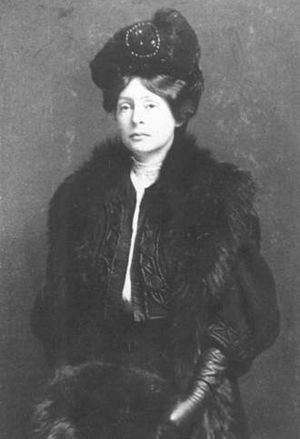Neith Boyce facts for kids
Quick facts for kids
Neith Boyce
|
|
|---|---|
 |
|
| Born | March 21, 1872 Franklin, Indiana |
| Died | December 2, 1951 (aged 79) Richmond, New Hampshire |
| Occupation | Dramatist |
| Nationality | American |
Neith Boyce (born March 21, 1872 – died December 2, 1951) was an American writer and theatre artist. She wrote novels, worked as a journalist, and created plays. Her parents, Mary and Henry Harrison Boyce, helped her publish some of her first writings.
Neith Boyce later helped start a famous theatre group called the Provincetown Players. She worked with this group in many ways. She directed plays, acted in them, and even hosted shows at her home. All four of her plays were performed by the Provincetown Players. Her plays often explored personal relationships and how people make their own choices.
Contents
Early Life and Learning
Neith Boyce was born in Franklin, Indiana. She was the second of five children born to Henry Harrison Boyce and Mary Boyce. Sadly, a serious sickness in 1880 caused the death of all her brothers and sisters, except for Neith. After this, the family moved from Milwaukee to Indiana, and then settled in Los Angeles.
Neith learned a lot by herself at home in California. She read many books from her parents' library. Later, she went to a college in Los Angeles. Like many young women at that time, Neith also took music lessons.
A Career in Writing
Early Journalism and Books
Neith started writing and publishing when she was a teenager in the 1880s. Her first articles appeared in the Los Angeles Times, a newspaper her father helped start. By the mid-1880s, the Boyce family was very well-known in Los Angeles.
In 1891, her family moved to Boston. There, her mother, Mary Boyce, became an editor for The Cycle. This magazine focused on women's rights. Mary helped Neith publish many of her writings and poems. One of Neith's first published works with her mother's help was about "women’s nature poetry."
After her family moved to New York in 1896, Neith began publishing articles and short stories. She had great success with her work in Vogue magazine.
By the late 1890s, Neith Boyce lived in Greenwich Village, New York City. She shared a home with two other young women who were also paid newspaper writers. They all wrote for different newspapers in the city. Neith Boyce worked for Lincoln Steffens, who was an editor at The Commercial Advertiser. In 1896, Boyce published her first book, called The Chap-Book.
Becoming a Playwright
Neith Boyce's husband, Hutchins Hapgood, often spent summers in Provincetown, Massachusetts. Neith became involved with the local group of women who wrote plays there. She was one of the people who helped create the Provincetown Players.
All four of Neith Boyce’s plays were first performed by this theatre group. She also wrote, directed, and acted for the company.
Her plays often explored important ideas, such as:
- The idea that young people might need to try out different relationships to avoid big mistakes.
- How much power social rules have, for good or bad.
- The challenges women face when they have to manage life on their own.
- The general difficulties in women's lives.
Boyce’s play Constancy (1914) was the first play performed by the group that would become the Provincetown Players. The play was about the lively relationship between two of her summer neighbors, Mabel Dodge and John Reed. Boyce used humor to talk about unfair expectations in relationships. In the play, the main male character, Rex, cannot stay loyal to his lover, Moira. Yet, he expects her to wait for him while he is with other people. This topic showed Boyce’s thoughts on unfairness in her own marriage and among some men in the Provincetown Players.
The second play produced was Enemies (1916). Neith Boyce wrote this play with her husband. Enemies was a conversation between a man and a woman. It showed the disagreements between men and women at that time. Neith Boyce wrote the woman’s lines, and Hutchins Hapgood wrote the man’s. The couple even acted in the play when it first opened in Provincetown. Enemies was also one of the first plays ever produced for radio.
Two other plays, Two Sons and Winter’s Night, were produced in 1916. However, Winter’s Night was not printed as a book until 1928. This printed version had some changes from the original play performed in Provincetown. Winter’s Night tells the story of a woman who turns down a marriage proposal from her late husband's brother. He wanted her to start a dress-making business with him.
Personal Life
Neith Boyce met her husband, Hutchins Hapgood, while they both worked for The Commercial Advertiser. Hapgood was also a successful writer and journalist for many years. They got married on June 22, 1899.
Neith and Hutchins were friends and advisors to many famous people. These included Mabel Dodge, Djuna Barnes, Alfred Stieglitz, Georgia O’Keeffe, and Gertrude Stein.
Their marriage was often described as a "modern marriage." This meant both partners were supposed to be equal and not bound by strict rules. However, Neith was mostly responsible for their children. Her husband, Hutchins, had many relationships outside their marriage. He also felt jealous, which limited Neith's freedom. One important way Neith found freedom was through her writing. She used her plays and stories to express her feelings and frustrations.
Neith Boyce passed away in Richmond, New Hampshire.


